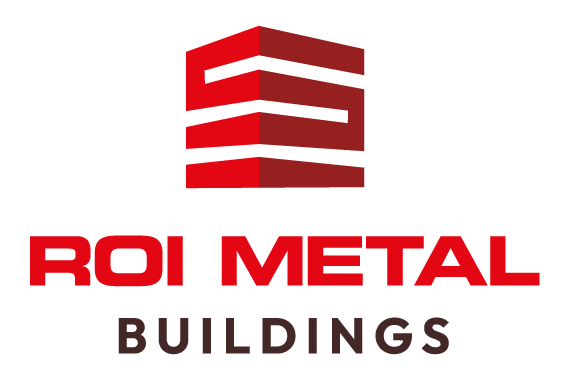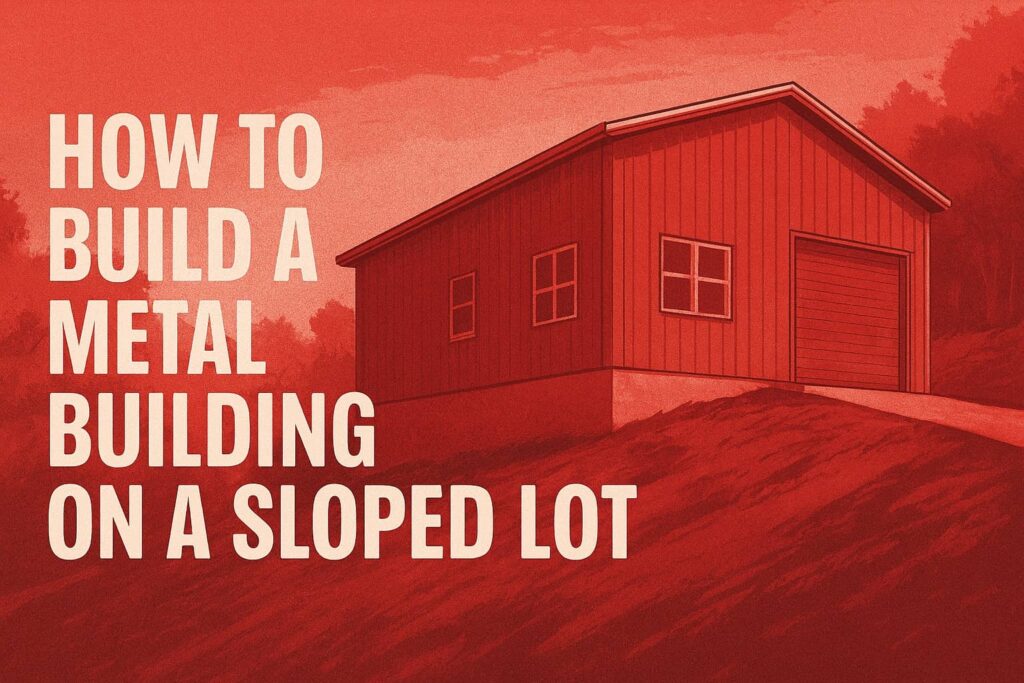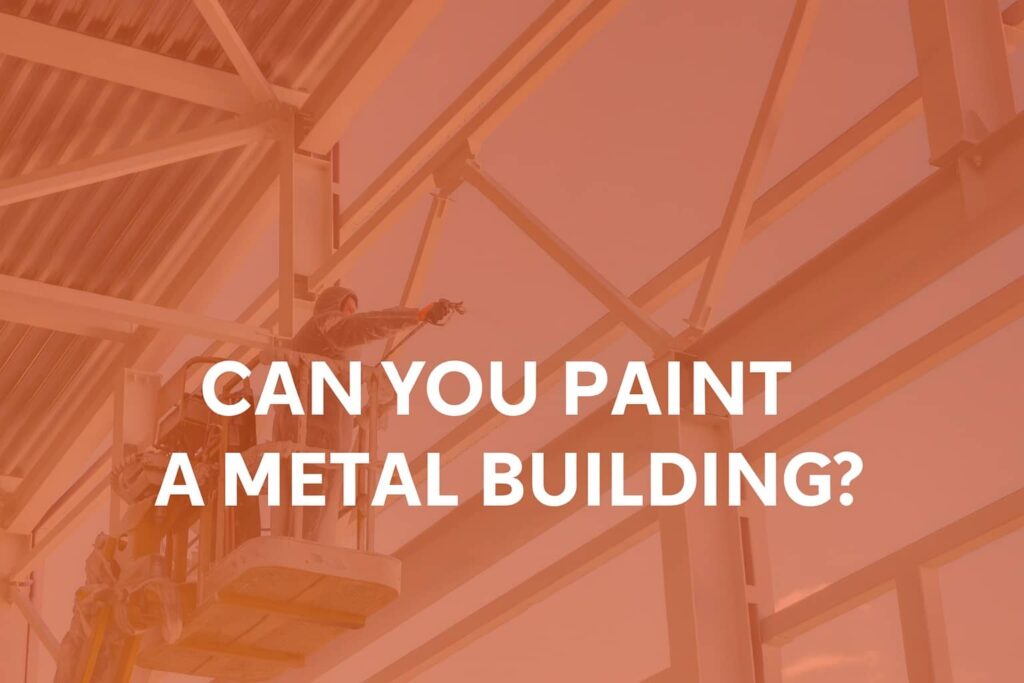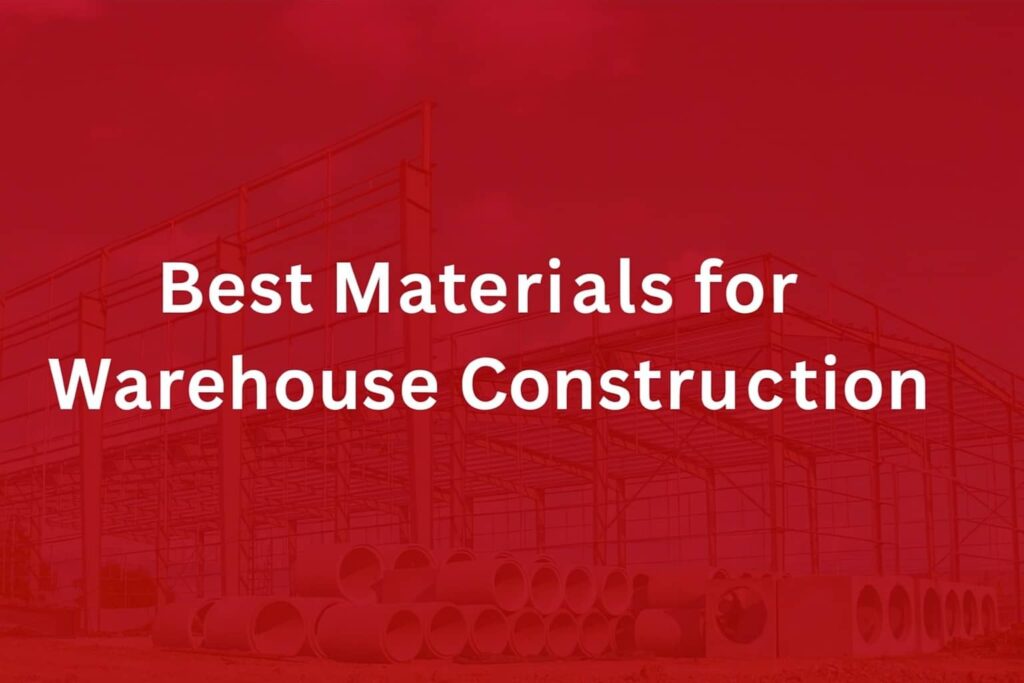Metal buildings offer a robust solution to diverse agricultural needs, cracking the code for both plant and animal farming operations. Their resilience against harsh weather conditions and varied climates, from heavy snow to intense heat, shields your crops and animals like a trusted guardian. Now, here’s something you might not have expected – these metal marvels are not just durable but also economical, giving your wallet the respite it deserves. Affordability in construction and maintenance makes them a farmer’s ally in smart investing. As we dive deeper, you’ll discover exactly why this metal might just be the gold standard in agricultural structures.
Before we begin, just a quick reminder. We wrote another detailed article last week about metal buildings vs concrete building systems. Today’s article is a part of a mini-series we will be publishing focusing on the benefits of metal buildings for agricultural needs.
Metal buildings in agriculture serve a variety of crucial purposes, including livestock shelters, crop storage and processing facilities, equipment storage, agricultural workshops, and riding arenas. These structures offer durability, cost-effectiveness, and sustainability benefits, making them an ideal choice for modern farming operations.-effectiveness, and higher sustainability due to the recyclability of steel. Additionally, metal buildings have lower long-term maintenance costs compared to concrete buildings, making them an attractive option for many construction projects.
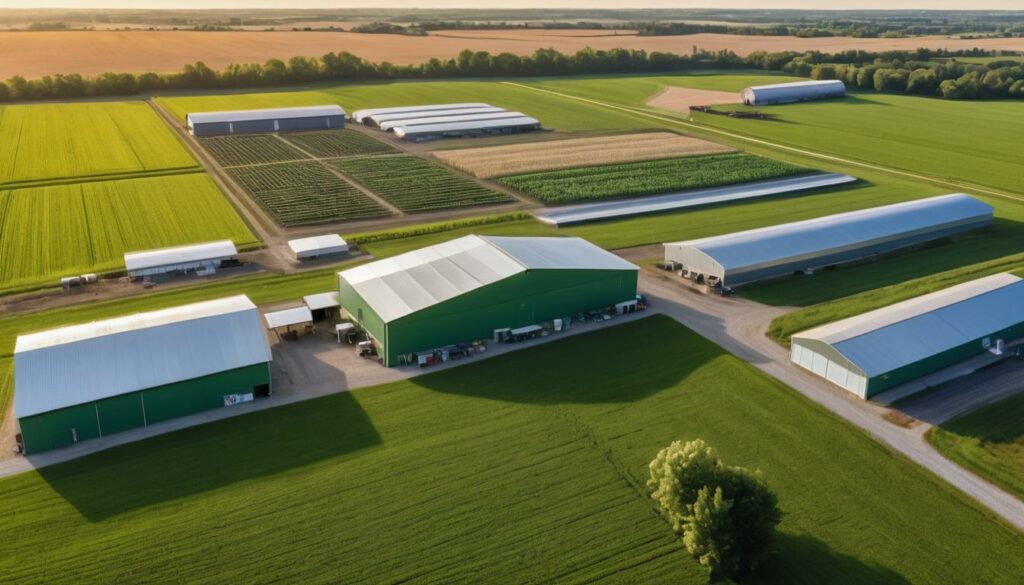
Ideal Conditions for Metal Buildings in Agriculture
Metal buildings have gained widespread acclaim in the agricultural sphere due to their adaptability across diverse climate conditions. From the scorching heat of arid regions to the biting cold of northern territories, metal buildings are built to stand firm amidst nature’s most extreme manifestations. Their design and construction materials are specifically engineered to withstand the elements, ensuring long-term resilience and protection for farming and livestock operations.
In areas prone to heavy snowfall, metal buildings offer exceptional structural support, capable of withstanding the weight of accumulated snow without caving in. This is essential for ensuring vital farm equipment, produce, or livestock remain sheltered and secure during harsh winter conditions. Additionally, their ability to resist strong winds and intense heat makes them a reliable choice for regions vulnerable to extreme weather events such as hurricanes or heatwaves.
The durability of metal buildings instills confidence in farmers and ranchers, knowing that their valuable assets and livelihoods are shielded from the unpredictable forces of nature. This peace of mind allows agricultural operations to continue without undue disruption, even in regions with notoriously harsh climatic challenges.
For instance, in the blistering heat of southern farming regions, metal buildings provide a cool refuge for both livestock and storage facilities. Their adeptness at maintaining stable interior temperatures creates comfortable environments for animals and safeguards perishable crops or feed from spoiling in excessive heat.
Moreover, in frigid northern climates, the insulative properties of metal buildings help maintain warmth within the structure, offering protection against freezing temperatures. This is particularly beneficial for preserving sensitive farming equipment and ensuring livestock are kept safe from the biting cold throughout winter.
The adaptability of metal buildings to diverse climate conditions stands as a testament to their suitability for agricultural use. Farmers can rely on these structures to provide consistent protection and support, regardless of the environmental challenges they face.
Metal buildings’ ability to endure various weather extremes contributes significantly to their widespread popularity in agricultural settings. Their capacity to accommodate different climate conditions bolsters the reliability and utility they offer to farming and livestock operations.
Economic Viability of Metal Farm Structures
When evaluating the most cost-effective options for constructing agricultural structures, it’s crucial to consider not only the initial construction costs but also the long-term value and maintenance expenditures. This is where metal farm buildings have a distinct advantage over traditional wood or brick structures.
First, let’s talk about the cost. One of the key advantages of metal farm buildings is their affordability. When compared to structures made of wood or brick, metal buildings are typically more cost-effective to construct. The materials used in these buildings are generally cheaper, and the construction process is often quicker and more straightforward.
Secondly, as a farm owner, you know that maintenance costs can add up over time. Metal buildings are known for being durable and low-maintenance. Their resistance to environmental factors like wind, rain, and pests means that upkeep costs are significantly reduced compared to traditional structures.
Thirdly, another economic advantage of metal farm buildings is their versatility. These structures can be easily modified or expanded at a lower cost than traditional buildings, providing flexibility for future upgrades or changes in farm requirements without breaking the bank.
For instance, if your livestock operation grows and you need additional space for housing animals or storage, it’s often much easier to modify a metal building to accommodate these changes compared to altering a traditional wooden structure. The ability to adapt to changing needs without incurring exorbitant expenses is a substantial advantage.
In summary, the economic viability of metal farm structures is a result of their initial cost-effectiveness in construction, lower long-term maintenance costs due to their durability, and their flexibility for future modifications or expansions. These factors collectively make them an attractive and practical choice for farmers seeking sustainable and affordable infrastructure solutions for their agricultural operations. For more information on cost-effective metal buildings, visit National Metal Building Sales.
Understanding the economic benefits of metal farm structures paves the way for exploring their versatile applications across diverse agricultural needs in the upcoming section.
Versatile Uses for Metal Agricultural Buildings
Metal agricultural buildings are like a multi-tool that can be customized to meet various farming needs. Let’s explore these versatile uses in more detail to discover why they’re such a boon for farming and livestock businesses.
First up, equipment storage comes to mind—these metal structures provide a safe and secure space to store all your farming gear, from tractors and plows to tools and machinery, efficiently organizing equipment while making it easier to access what you need when you need it.
Next, consider livestock shelters—a vital component of any farm setup. Distinctly weather-resistant and durable, metal buildings offer an ideal solution for creating safe and comfortable housing for animals. They protect livestock from harsh weather conditions such as scorching sun, heavy rain, or snow, aiding in their overall well-being and productivity.
Now, onto crop storage and processing facilities. Metal buildings provide the perfect environment for storing crops such as grains or vegetables. Additionally, they facilitate essential processing activities like cleaning, drying, and packing. Their spacious design allows for efficient organization and easy access to stored produce.
Just as crucial is the agricultural workshop held within a metal building. This is where farmers perform crucial equipment repair and maintenance work. The customizable layout of these buildings, combined with safety features, makes them conducive to fostering a productive and secure work environment.
The adaptability of metal agricultural buildings transcends these conventional uses. Let’s continue to explore how they cater to the diverse needs of modern-day farming enterprises by providing multifunctional spaces that evolve with changing requirements.
Equipment and Crop Storage Solutions
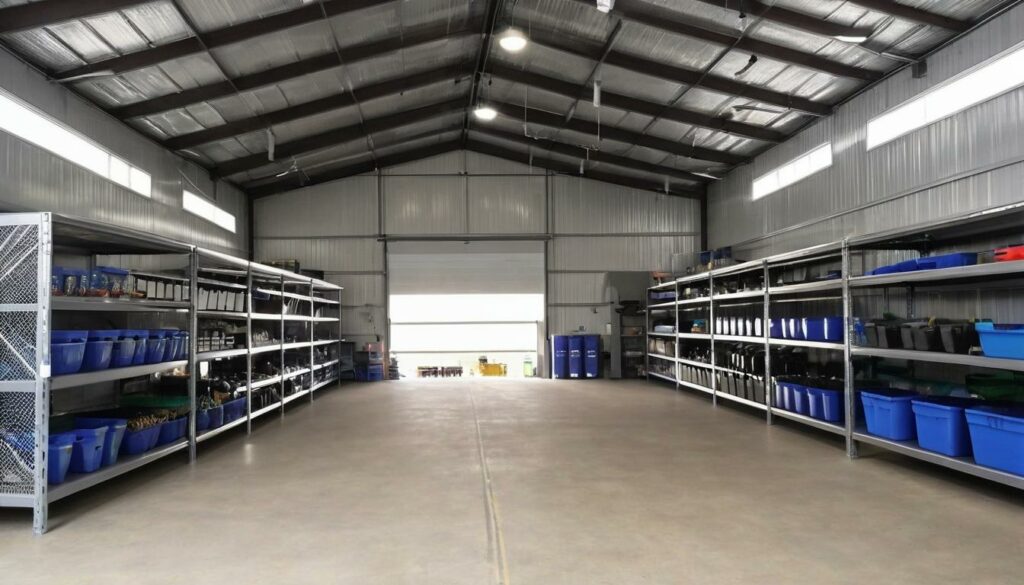
Metal storage buildings serve as the unsung heroes on a farm – they keep everything in place, safe, and well-organized without demanding much attention in return. Consider the busy atmosphere of a farm, with numerous equipment and supplies to manage. From plows, tractors, and harvesters to irrigation tools, fertilizer, and pesticides—these are just the basics! Ensuring that all this machinery is well-protected from the elements is crucial for the smooth functioning of a farm.
With a sturdy metal storage building, not only can you safeguard your expensive farm equipment from weather-related damage, but you can also establish an efficient and organized environment. Everything has its place, easily accessible and protected from rust or decay—ultimately contributing to improved operational workflows and asset management within the farm.
Furthermore, these buildings offer reliable storage options for crop-related equipment such as planting machinery, grain bins, pesticide sprayers, and fertilizing equipment. This dedicated space allows farmers to streamline their daily tasks by efficiently storing and accessing what they need during planting or harvesting seasons. Such practices not only save time but also help protect expensive machinery from premature wear and tear due to exposure to the elements.
Imagine walking into a well-organized metal storage building on a farm: every tool hanging neatly on hooks or placed in specific areas, ready for use at a moment’s notice. From shovels to chainsaws, everything is stored systematically, ensuring that nothing ever goes missing when it’s time to get work done—an organizational aesthetic that directly impacts productivity and efficiency.
In essence, these buildings become integral to the farming operation—an unsung cornerstone of success. As with any enterprise, being able to access tools and equipment quickly and efficiently can mean the difference between completing an essential task on time or facing unnecessary delays that may affect yield or quality. The role of metal storage buildings extends beyond mere protection; it actively contributes to the overall functionality and effectiveness of the entire farming operation.
Metal storage buildings aren’t just about protecting equipment; they’re about optimizing workflows and safeguarding valuable assets, thereby ensuring that the farm operates at its full capacity while maintaining high standards of efficiency.
As we explore the crucial facets of agricultural infrastructure enhancement through metal constructions, let’s now shift our focus to specialized structures that cater to the wellbeing of farm animals.
Metal Barns for Animal Welfare
Creating Comfortable Environments
When it comes to agricultural practices, the well-being of livestock takes center stage. Metal barns provide a safe haven for animals, shielding them from harsh weather conditions and offering spacious, well-ventilated shelter areas. This controlled environment not only protects animals from extreme heat, cold, wind, and rain but also fosters an atmosphere where they can thrive and remain healthy.
Imagine a hot summer day or a chilly winter night – the animals under the sturdy roof of metal barns are shielded, enabling them to rest peacefully without being exposed to extreme elements. Adequate ventilation ensures that the air inside remains fresh and prevents the buildup of harmful gases. In essence, these barns create a comfortable microclimate that contributes significantly to the overall health and welfare of the animals.
Durable Construction for Long-term Protection
The robust construction of metal barns is pivotal in safeguarding livestock. These structures are built to endure harsh environmental factors and are resistant to damage caused by inclement weather. This durability ensures long-term protection for the animals, offering security even during adverse weather conditions such as strong winds, heavy rainfall, or snowstorms.
Furthermore, the longevity of metal barns means that farmers have a reliable solution for providing consistent shelter to their livestock year after year. It’s akin to providing a dependable sanctuary for animals across various seasons, thereby demonstrating an unwavering commitment to their well-being.
Supporting Modern Agricultural Practices
In today’s agricultural landscape, animal welfare has emerged as a fundamental priority. With consumers expressing heightened concern for the treatment and living conditions of farm animals, there is a growing emphasis on promoting humane practices within the industry. Metal barns stand as an embodiment of this ethos, symbolizing a tangible investment in creating conducive environments for livestock.
Additionally, these barns align with sustainable farming approaches by minimizing the environmental impact of animal shelters. Their longevity reduces the need for frequent replacements or extensive maintenance, ultimately contributing to resource efficiency and eco-friendly agricultural operations.
As we’ve witnessed, metal barns go beyond simple shelter; they serve as guardians of animal welfare, embodying resilience against nature’s forces while nurturing a harmonious space for livestock to thrive.
With a solid understanding of how metal barns positively impact animal welfare and health in agricultural settings, let’s now pivot towards exploring another vital aspect—climate control within metal farm structures.
Climate Control in Metal Farm Structures
When it comes to running a successful agricultural operation, creating and maintaining optimal environmental conditions is vital. Metal farm structures offer a wide range of customizable climate control solutions that can drastically enhance farming productivity and livestock welfare. Let’s explore some key aspects of climate control in metal farm structures.
Insulation and Ventilation: Proper insulation and ventilation systems are crucial for climate control in metal farm structures. Insulation helps regulate the temperature inside the building, keeping it warm during colder months and cool during hot seasons. Additionally, effective ventilation systems ensure proper air circulation, preventing the buildup of harmful gases and excessive moisture that could compromise crop quality or animal health.
Regulating Temperature and Humidity: Metal farm structures can be equipped with climate control technology to precisely regulate temperature and humidity levels. This is particularly important for crop storage and animal housing. Controlling humidity levels prevents mold growth in stored crops, while maintaining ideal temperatures ensures the comfort and well-being of livestock.
Enhanced Crop Storage: Metal farm structures with advanced climate control features provide an ideal environment for preserving crops. Specific temperature and humidity settings can be programmed to prolong the shelf life of fruits, vegetables, and grains, ultimately reducing waste and maximizing profitability.
Animal Welfare: Livestock housed in metal barns benefit from controlled environments that ensure their comfort and overall well-being. By regulating temperature and humidity levels, farmers can mitigate stress on animals during extreme weather conditions, leading to healthier livestock and improved breeding outcomes.
In essence, integrating climate control systems in metal farm structures empowers farmers to create tailored environments that support the diverse needs of agriculture. Whether it’s optimizing crop storage conditions or ensuring livestock welfare, these advancements play a pivotal role in modern agricultural practices, ultimately contributing to improved yields and sustainable farming. The ability to provide such precision in environmental control sets metal buildings apart as essential assets in contemporary farming operations.
Exploring the intricacies of climate control in metal farm structures sheds light on the vital considerations when selecting a metal building that best suits specific agricultural needs.
Selecting the Right Metal Building for Your Agricultural Needs
When it comes to selecting a metal building for your agricultural needs, various crucial factors come into play. The size of the building, its intended use, climate control options, and interior layout efficiency all contribute significantly to the suitability of the structure for your farming operation.
Size is one of the fundamental considerations when choosing a metal building. It’s essential that the selected size aligns with the specific requirements of your farming operations. For instance, a 60×80 metal building provides 4,800 square feet of space, offering ample room for diverse agricultural activities, including storage needs and equipment accommodation.
Equally significant is the intended use of the building. Whether it’s for housing livestock, storing crops and equipment, or serving as a workspace for agricultural activities, each intended use warrants different design features and structural considerations.
Considering climate control options is vital to ensure effective agricultural activities throughout the year. Insulation options and proper ventilation systems are essential for maintaining optimal conditions within the structure. This becomes particularly crucial in regions with extreme weather conditions where these features contribute significantly to the comfort and well-being of both livestock and workers.
Additionally, interior layout efficiency must not be overlooked. The organization and layout within the interior space can significantly impact workflow efficiency and overall productivity. Clear span designs maximize usable space, allowing unobstructed movement within the building and effective accommodation of equipment and storage requirements.
By carefully evaluating these aspects and tailoring your choice to align with the long-term goals and objectives of your agricultural enterprise, you can ensure that the chosen structure fulfills both your immediate needs and future aspirations in agriculture.
When making the decision to invest in a metal building for your agricultural endeavors, it’s imperative to consider these crucial factors to meet your specific requirements effectively. Ensuring a well-informed decision will pave the way for a functional and productive agricultural facility. To discuss your customized metal building needs further, feel free to contact us on our site or call us at 865-316-9009.
A Detailed Breakdown of the Benefits of Metal Buildings in Agriculture
When making the decision to invest in a metal building for your agricultural endeavors, it’s imperative to consider these crucial factors to meet your specific requirements effectively. Ensuring a well-informed decision will pave the way for a functional and productive agricultural facility. With these factors in mind, you can confidently choose the most suitable option for your project needs. Call us directly at (865) 316-9009 to get started! Also, if you like our content and want to stay up to date, follow us on Facebook at https://www.facebook.com/roimetalbuildings!
